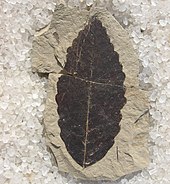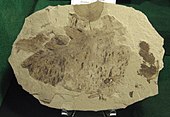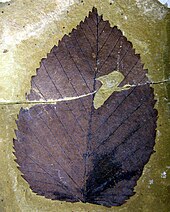Formation d'Allenby
| Formation d'Allenby | |
| Localisation | |
|---|---|
| Pays | |
| Informations géologiques | |
| Période | Éocène supérieur et moyen |
| Âge | 52.5–48.0 Ma |
| modifier |
|
La formation d'Allenby est une formation géologique de roches sédimentaires d'âge Éocène supérieur et moyen située en Colombie Britannique (Canada). Elle est constituée de conglomérats, de grès entrelacés de shale et de charbon. Les gisements de charbon contiennent une abondance de fossiles d'insectes, de poissons et de plantes, issus des shales depuis 1877[1], les plus connus sont ceux de Princeton Chert.
Flore[modifier | modifier le code]
Conifères, fougères et ginkgos[modifier | modifier le code]
| Nom | Autorité | Année | Famille | Images |
|---|---|---|---|---|
|
2013 |
 | |||
|
Arnold, 1955 |
1955 |
 | ||
|
2002 |
 | |||
|
Mustoe, 2002 |
2002 |
 | ||
|
1987 |
 |
Angiospermes[modifier | modifier le code]
| Nom | Autorité | Année | Famille | Images |
|---|---|---|---|---|
|
Wolfe & Tanai |
1987 |
|||
|
Wolfe & Tanai |
1987 |
|||
|
Wolfe & Tanai |
1987 |
|||
|
Wolfe & Tanai |
1987 |
|||
|
(Berry) Wolfe & Wehr |
2013 |
 | ||
|
Wolfe & Wehr |
1987 |
 | ||
|
(Knowlton) Wolfe & Wehr |
2013 |
 | ||
|
Radtke, Pigg, & Wehr |
2005 |
Hamamelidaceae |
||
|
2004 |
||||
|
2007 |
 | |||
|
Stockey & Manchester |
1988 |
incertae sedis |
||
|
Pigg, Manchester, & Wehr |
2003 |
Betulaceae |
||
|
1988 |
||||
|
Pigg et al |
2007 |
 | ||
|
Wolfe & Wehr |
2013 |
 | ||
|
Denk & Dillhoff |
2007 |
 |
Animaux[modifier | modifier le code]
Insectes[modifier | modifier le code]
| Nom | Autorité | Année | Famille | Images |
|---|---|---|---|---|
|
Archibald, 2005 |
2005 |
|||
|
Rice, 1968 |
1968 |
|||
|
Rice, 1968 |
1968 |
Mammifères[modifier | modifier le code]
| Name | Autorité | Année | Famille | Images |
|---|---|---|---|---|
|
Eberle, 2017 |
1935 |
Notes et références[modifier | modifier le code]
- (en) Cet article est partiellement ou en totalité issu de l’article de Wikipédia en anglais intitulé « Allenby Formation » (voir la liste des auteurs).
- R.M. Dillhoff, T.A. Dillhoff, D.R. Greenwood, M.L. DeVore et K.B. Pigg, « The Eocene Thomas Ranch flora, Allenby Formation, Princeton, British Columbia, Canada », Botany, vol. 91, , p. 514–529 (DOI 10.1139/cjb-2012-0313)
- C. A. Arnold, « Un Tertiary Azolla from British Columbia », Contributions from the Museum of Paleontology, University of Michigan, vol. 12, no 4, , p. 37–45 (lire en ligne)
- G.E. Mustoe, « Eocene Ginkgo leaf fossils from the Pacific Northwest », Canadian Journal of Botany, vol. 80, no 10, , p. 1078–1087 (DOI 10.1139/b02-097)
- R.W. Chaney, « Un revision of fossil Sequoia and Taxodium in western North America based on the recent discovery of Metasequoia », Transactions of the American Philosophical Society, vol. 40, no 3, , p. 231
- J.A. Wolfe et T. Tanai, « Systematics, Phylogeny, and Distribution of Acer (maples) in the Cenozoic of Western North America », Journal of the Faculty of Science, Hokkaido University. Series 4, Geology and mineralogy, vol. 22, no 1, , p. 23, 74, 75, 240, & plate 4 (lire en ligne)
- J.A. Wolfe et W.C. Wehr, « Middle Eocene dicotyledonous plants from Republic, northeastern Washington », United States Geological Survey Bulletin, vol. 1597, , p. 1–25
- M.G. Radtke, K.B. Pigg et W.C. Wehr, « Fossil Corylopsis and Fothergilla Leaves (Hamamelidaceae) from the Lower Eocene Flora of Republic, Washington, U.S.A., and Their Evolutionary and Biogeographic Significance », International Journal of Plant Sciences, vol. 166, no 2, , p. 347–356 (DOI 10.1086/427483)
- M.L. DeVore, S.M. Moore, K.B. Pigg et W.C. Wehr, « Fossil Neviusia leaves (Rosaceae: Kerrieae) from the Lower Middle Eocene of Southern British Columbia », Rhodora, vol. 12, no 927, , p. 197–209 (JSTOR 23314752, lire en ligne)
- J. Bogner, K. R. Johnson, Z. Kvacek et G. R. Upchurch, « New fossil leaves of Araceae from the Late Cretaceous and Paleogene of western North America », Zitteliana, vol. A, no 47, , p. 133–147 (ISSN 1612-412X, lire en ligne)
- R. A. Stockey et S. R. Manchester, « A fossil flower with in situ Pistillipollenites from the Eocene of British Columbia », Canadian Journal of Botany, vol. 66, no 2, , p. 313-318
- K.B. Pigg, Manchester S.R. et Wehr W.C., « Corylus, Carpinus, and Palaeocarpinus (Betulaceae) from the Middle Eocene Klondike Mountain and Allenby Formations of Northwestern North America », International Journal of Plant Sciences, vol. 164, no 5, , p. 807–822 (DOI 10.1086/376816)
- J.A. Wolfe et W.C. Wehr, « Rosaceous Chamaebatiaria-like foliage from the Paleogene of western North America », Aliso, vol. 12, no 1, , p. 177–200 (lire en ligne)
- S. Manchester, K. B. Pigg, Z Kvaček, M. L. DeVore et R. M. Dillhoff, « Newly recognized diversity in Trochodendraceae from the Eocene of western North America », International Journal of Plant Sciences, vol. 179, no 8, , p. 663–676 (DOI 10.1086/699282)
- T. Denk et R.M. Dillhoff, « Ulmus leaves and fruits from the Early-Middle Eocene of northwestern North America: systematics and implications for character evolution within Ulmaceae », Canadian Journal of Botany, vol. 83, no 12, , p. 1663–1681 (DOI 10.1139/b05-122)
- S.B. Archibald, « New Dinopanorpidae (Insecta: Mecoptera) from the Eocene Okanagan Highlands (British Columbia, Canada and Washington State, USA) », Canadian Journal of Earth Sciences, vol. 42, no 2, , p. 119–136 (DOI 10.1139/e04-073)
- Rice, H.M.A., « Two Tertiary sawflies, (Hymenoptera - Tenthredinidae), from British Columbia », Geological Survey of Canada, vol. 67, no 59, , p. 1–21
- Russell, L.S. 1935. A middle Eocene mammal from British Columbia. American Journal of Science, 29: 54–55.
- Eberle, J.J., & Greenwood, D.R. (2017). An Eocene brontothere and tillodonts (Mammalia) from British Columbia, and their paleoenvironments. Canadian Journal of Earth Sciences, 54(9): 981-992.
